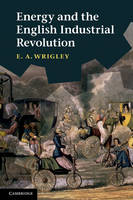
Energy and the English Industrial Revolution
Cambridge University Press (Verlag)
978-0-521-13185-8 (ISBN)
The industrial revolution transformed the productive power of societies. It did so by vastly increasing the individual productivity, thus delivering whole populations from poverty. In this new account by one of the world's acknowledged authorities the central issue is not simply how the revolution began but still more why it did not quickly end. The answer lay in the use of a new source of energy. Pre-industrial societies had access only to very limited energy supplies. As long as mechanical energy came principally from human or animal muscle and heat energy from wood, the maximum attainable level of productivity was bound to be low. Exploitation of a new source of energy in the form of coal provided an escape route from the constraints of an organic economy but also brought novel dangers. Since this happened first in England, its experience has a special fascination, though other countries rapidly followed suit.
Sir Tony Wrigley is a member and co-founder of the Cambridge Group for the History of Population and Social Structure and a former President of the British Academy. His previous publications include Population and History (1969), People, Cities and Wealth (1987), Continuity, Chance and Change (1988), Poverty, Progress, and Population (2004), and, with R. S. Schofield, The Population History of England 1541–1871 (1981).
List of figures; List of tables; Acknowledgements; Introduction; Part I. A Sketch of the Argument: 1. The limits to growth in organic economies; 2. The transition from an organic to an energy-rich economy; Part II. Favourable Developments: 3. Agricultural change and urbanisation; 4. Energy and transport; 5. Occupational structure, aggregate income, and migration; 6. Production and reproduction; Part III. What Set England Apart from her Neighbours: 7. The timing and nature of change in the industrial revolution; 8. Modernisation and the industrial revolution; Part IV. Retrospective: 9. The industrial revolution and energy; Appendix 1. Fuller versions of three tables printed in the main text; Bibliography; Index.
| Erscheint lt. Verlag | 19.8.2010 |
|---|---|
| Zusatzinfo | 1 Maps; 10 Halftones, black and white |
| Verlagsort | Cambridge |
| Sprache | englisch |
| Maße | 153 x 228 mm |
| Gewicht | 470 g |
| Themenwelt | Geschichte ► Allgemeine Geschichte ► Neuzeit (bis 1918) |
| Geisteswissenschaften ► Geschichte ► Regional- / Ländergeschichte | |
| Geschichte ► Teilgebiete der Geschichte ► Wirtschaftsgeschichte | |
| Technik ► Bergbau | |
| Technik ► Elektrotechnik / Energietechnik | |
| ISBN-10 | 0-521-13185-5 / 0521131855 |
| ISBN-13 | 978-0-521-13185-8 / 9780521131858 |
| Zustand | Neuware |
| Haben Sie eine Frage zum Produkt? |
aus dem Bereich


